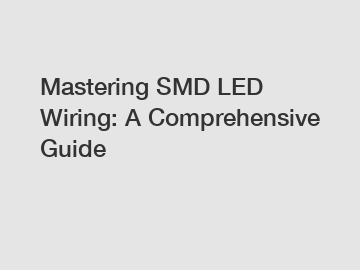Jan. 19, 2024
Lights & Lighting
Mastering SMD LED Wiring: A Comprehensive Guide.
Welcome to our comprehensive guide on mastering Surface Mount Device (SMD) LED wiring. In this article, we will delve deep into the intricacies of SMD LED wiring and provide you with expert insights and tips to ensure your LED projects shine brightly. Whether you are a beginner or an experienced LED enthusiast, this guide will cater to your needs and help you achieve professional results.
With the growing popularity of SMD LEDs in various applications, understanding the correct methodology for wiring them is crucial. These tiny electronic components offer a multitude of advantages, including compact size, improved energy efficiency, and enhanced durability. However, due to their size, they require careful handling during the wiring process.

To ensure a high level of expertise and mastery over SMD LED wiring, it is imperative to follow a systematic approach. Here is a step-by-step breakdown of the process:
Step 1: Gather the Necessary Tools and Supplies.
Before diving into your wiring project, it's essential to gather all the required tools and supplies. These typically include SMD LEDs of your choice, an appropriate soldering iron, solder wire, flux, tweezers, magnifying glass, and a soldering station. Having these items readily available will facilitate a smooth and efficient wiring process.
Step 2: Understand the LED Datasheet.
Each SMD LED comes with its own datasheet, which contains critical information regarding the LED's electrical and physical specifications. Familiarize yourself with this datasheet to identify forward voltage, maximum current ratings, pin configuration, and other relevant details. This information will help you make informed decisions during the wiring process.
Step 3: Prepare the PCB.
Begin by preparing the Printed Circuit Board (PCB) upon which you will attach the SMD LEDs. Ensure that the PCB surface is clean, free of dust, and adequately prepped for soldering. Apply flux to the designated soldering areas to promote excellent solder adhesion.
Step 4: Determine LED Orientation and Placement.
Identify the correct orientation of the SMD LEDs by referring to the datasheet. Most SMD LEDs have a notch or dot indicating the cathode (-) side. Align the LEDs accordingly on the PCB, firmly holding them in place with tweezers or an appropriate tool. Ensure all LEDs are properly spaced to avoid shorts during soldering.
Step 5: Solder the LEDs.
Now comes the crucial step of soldering the SMD LEDs to the PCB. Preheat your soldering iron to the recommended temperature and begin by soldering the cathode (-) terminals of the LEDs. Apply a small amount of solder to the iron's tip and carefully touch it to the cathode pad, creating a secure bond. Repeat this process for all LEDs.
Step 6: Solder the Anode (+) Connections.
Proceed to solder the anode terminals of the SMD LEDs. This step requires delicacy, as close proximity of the anodes may pose a risk of short circuits. Apply solder to the anode pads seamlessly, ensuring a gap between the connections. Double-check for any solder bridges and rectify them promptly.
Step 7: Test the Completed Circuit.
After completing the soldering, it's crucial to test the circuit's functionality. Connect the appropriate power supply to the PCB and check if the LEDs light up as intended. If any LEDs fail to illuminate or display incorrect behavior, investigate potential issues such as faulty connections, incorrect voltage, or damaged components.
By following these steps and paying attention to detail, you can master the art of SMD LED wiring, creating dazzling LED projects with confidence.
In addition to the systematic approach, let's explore some additional considerations to enhance your SMD LED wiring expertise:
1. Proper Heat Management: SMD LEDs generate heat during operation, which can damage the surrounding components. Employ effective thermal management strategies, such as utilizing heat sinks or ensuring adequate air circulation, to prolong LED lifespan.
2. Current Limitation: SMD LEDs have maximum current ratings specified in their datasheets. Exceeding these limits can lead to premature failure. Therefore, incorporate suitable current-limiting resistors or constant current drivers in your circuit design.
3. Advanced Techniques: Consider exploring techniques like reflow soldering when dealing with large quantities of SMD LEDs. Reflow soldering offers precise and efficient solder connections, resulting in reliable and professional-grade LED projects.
In conclusion, mastering SMD LED wiring requires a combination of theoretical knowledge, hands-on experience, and attention to detail. By adopting a systematic approach, understanding datasheets, and incorporating best practices, you can elevate your LED projects to the next level. Embrace the creativity, bursts of inspiration, and human-like precision as you embark on your journey to becoming a master in SMD LED wiring.
If you want to learn more, please visit our website dip led voltage, China high power smd led Factory, dip led board.
Previous: Ultimate Guide: How to Choose Weatherproof Lighting Fixtures for Long-lasting Outdoor Illumination
If you are interested in sending in a Guest Blogger Submission,welcome to write for us!
All Comments ( 0 )